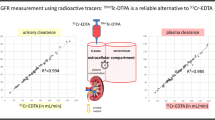Abstract.
The plasma clearance curves of small hydrophilic solutes comprise three exponentials, consistent with a three-compartmental distribution model. A previous comparison between inulin and diethylene triamine penta-acetic acid (DTPA) suggested that these three compartments are in series, the first being plasma and the second and third representing compartments within the extravascular space. Moreover, whilst the total distribution volumes of these two indicators were similar, the volume of the second compartment was higher for DTPA. The purpose of the current study was to investigate whether a solute smaller than DTPA, namely bromide, fits the hypothesis that the second space volume is an inverse function of the size of the solute. Two groups of subjects were studied: group A comprised eight patients undergoing routine diagnostic arteriography and group B, eight patients referred for routine measurement of glomerular filtration rate plus two normal volunteers. 99mTc-DTPA and sodium [77Br]bromide were intravenously administered simultaneously. In group A, frequent arterial samples were obtained up to 40 min after injection, and antecubital venous samples 30 s after each arterial sample. In group B, frequent venous samples were obtained up to 280 min after injection. Volume measurements based on bromide were corrected for erythrocyte bromide accumulation. In both subject groups, the normalised venous concentration ratio of bromide to DTPA, corrected for red cell bromide uptake, was significantly less than unity in the earliest blood samples, being 0.56 (SD 0.08) at 1 min, consistent with faster diffusion of bromide from plasma to interstitial fluid. Furthermore, the extraction fraction of bromide from plasma to interstitial fluid in the forearm was about 0.6, higher than that of DTPA (about 0.5) in spite of red cell bromide accumulation which equilibrated with plasma bromide within 20 s and resulted in a red cell to plasma concentration ratio of 0.51 (0.09). Nevertheless, the net extraction fractions of the two solutes approached asymptotic values with identical time courses over 20–25 min. The total volume of distribution of bromide in group B was 22.5 (3.8) litres, which was higher than that of DTPA, 18.0 (2.8) litres (P<0.001). It was assumed that this difference was the result of intracellular bromide accumulation. After correction for this, the combined volume of the first and second spaces was significantly higher for bromide, at 13.9 (2.9) litres, than for DTPA, 12.3 (2.0) litres (P<0.05), but the volume of the third space, 4.1 (2.8) litres, was less compared with DTPA, for which it was 5.8 (2.2) litres (P<0.05). The proportion of the total space occupied by the first and second spaces was also higher for bromide, 0.78 (0.14), than for DTPA, for which it was 0.69 (0.09; P<0.05). These data are consistent with a three-in series-compartmental model of solute distribution in which the volume of the second space is an inverse function of solute molecular size while the volume of the third is a positive function of solute size.
Similar content being viewed by others
Author information
Authors and Affiliations
Additional information
Received 3 August and in revised form 2 December 2001
Electronic Publication
Rights and permissions
About this article
Cite this article
Cousins, C., Skehan, S.J., Rolph, S.M. et al. Comparative microvascular exchange kinetics of [77Br]bromide and 99mTc-DTPA in humans. Eur J Nucl Med 29, 655–662 (2002). https://doi.org/10.1007/s00259-001-0746-5
Published:
Issue Date:
DOI: https://doi.org/10.1007/s00259-001-0746-5




